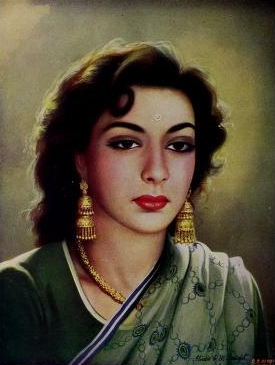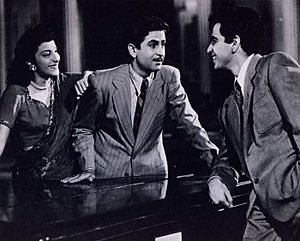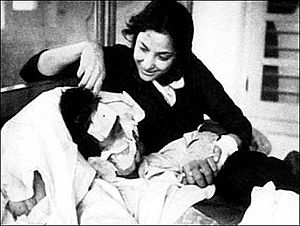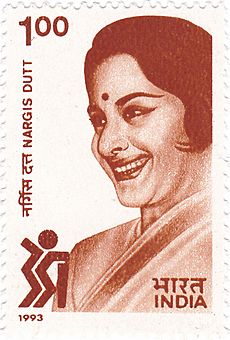Nargis facts for kids
Quick facts for kids
Nargis
|
|
|---|---|
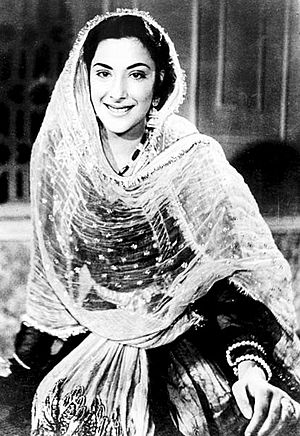 |
|
| Born |
Fatima Rashid
1 June 1929 |
| Died | 3 May 1981 (aged 51) |
| Resting place | Bada Qabrastan, Marine Lines, Mumbai |
| Nationality | British Indian (1929–1947) Indian (1947–1981) |
| Other names |
|
| Occupation |
|
| Years active | 1935–1936 1942–1968 |
|
Notable work
|
Barsaat (1949) Babul (1950) Awara (1951) Shree 420 (1955) Mother India (1957) Raat Aur Din (1967) |
| Spouse(s) | |
| Children | 3, including
|
| Parent(s) |
|
| Family | Dutt family (by marriage) |
| Awards |
|
| Honours | Padma Shri (1958) |
| Member of Parliament, Rajya Sabha | |
| In office 3 April 1980 – 3 May 1981 (her death) |
|
Nargis Dutt, born Fatima Rashid (June 1, 1929 – May 3, 1981), was a famous Indian actress and politician. She worked in Hindi cinema and is known as one of the greatest actresses in Indian film history. She first appeared in a small role at age five in Talash-E-Haq (1935). Her main acting career began with the film Tamanna in 1942.
Over three decades, Nargis starred in many successful and praised films. She often worked with actor Raj Kapoor. Her most famous role was Radha in the Oscar-nominated film Mother India (1957), which won her the Filmfare Award for Best Actress. In the 1960s, she appeared in fewer films. One notable film from this time was the drama Raat Aur Din (1967), for which she received the first-ever National Film Award for Best Actress.
Nargis married her Mother India co-star Sunil Dutt in 1958. They had three children, including the actor Sanjay Dutt. Nargis and her husband started the Ajanta Arts Culture Troupe. This group included many top actors and singers who performed for Indian soldiers in border areas. In the early 1970s, Nargis became the first supporter of The Spastic Society of India. Her work with this organization earned her recognition as a social worker. She was later nominated to the Rajya Sabha (India's Parliament) in 1980.
Nargis passed away in 1981 from pancreatic cancer. This was just three days before her son Sanjay Dutt's first film, Rocky, was released. In 1982, the Nargis Dutt Memorial Cancer Foundation was created in her memory. Also, an award for the best film promoting national unity is named the Nargis Dutt Award in her honor.
Contents
Early Life and Family Background
Nargis was born Fatima Rashid in Calcutta, Bengal Presidency, British Indian Empire. This area is now Kolkata, West Bengal, India. She came from a Bengali Muslim family. Her father, Abdul Rashid, was originally a wealthy Bengali Hindu named Mohanchand Uttamchand. He converted to Islam.
Her mother was Jaddanbai, a famous Hindustani classical music singer and an early pioneer in Indian cinema. Nargis' family later moved from Bengal to Prayagraj in Uttar Pradesh. Her mother helped Nargis enter the growing movie industry in India. Nargis' half-brother, Anwar Hussain, was also a film actor.
Nargis's Film Career
Early Roles and First Films (1935–1948)
Fatima first appeared in the 1935 film Talashe Haq when she was six years old. She was credited as Baby Nargis. The name Nargis (نرگس) is a Persian word for the daffodil flower. After this film, she was always known as Nargis in her movies.
Nargis acted in many films after her debut. In 1943, at age 14, she starred in Mehboob Khan's Taqdeer with Motilal. The film was a big success, and people praised her acting. Filmindia magazine called it an "excellent debut."
After Taqdeer, Nargis appeared in the 1945 film Humayun with Ashok Kumar. This film did moderately well. Some of her early films in 1948 included Mela, Anokha Pyar, and Aag. Mela was one of the highest-earning films that year. Aag was her first movie with Raj Kapoor.
Becoming a Star (1949–1951)
In 1949, Nargis starred in Mehboob Khan's drama Andaz. It started slowly but became a huge commercial success. It was the highest-earning film of its time. This film was a breakthrough for Nargis and for Raj Kapoor. After its success, Kapoor cast her again in his next film.
This film, Barsaat, was released in the same year. Nargis played a village girl, and Kapoor played a poet. The film was already popular because of Andaz's success. Barsaat became another major hit and the highest-earning film of 1949. This made Nargis one of the most popular stars of that time.
Next, Nargis played lead roles in the 1950 films Jogan and Babul, both with Dilip Kumar. Both films were box-office hits, and her acting in Babul was especially noticed.
Because of the success of Andaz and Barsaat, Raj Kapoor chose Nargis for his 1951 film Awaara. Nargis played an important role as a lawyer. She showed a strong, outspoken woman who spoke against those who thought women were only for housework. She even wore a swimwear in one scene, which was very bold for Indian women back then. Awaara was released on December 14, 1951, and received great reviews. It was a blockbuster not only in India but also overseas, making Nargis and Raj famous in countries like Greece and the USA. It became the highest-earning film ever, breaking the record of Barsaat. Deedar, released in the same year, was another hit for Nargis.
Career Challenges (1952–1954)
Nargis's films released between 1952 and 1954 did not do very well. In 1952, she had six films, but only Anhonee was a success. In 1953 and 1954, she made five films, but none were big hits. However, her 1953 film Aah has become a cult classic over the years.
Peak Years and Mother India (1955–1957)
Nargis's career got back on track with Raj Kapoor's film Shree 420 (1955). This film was the highest-earning film of its time and featured many popular songs.
She worked with Kapoor again in the successful film Chori Chori (1956). This movie is about a girl (Nargis) who runs away to marry a pilot but falls for a news reporter (Kapoor) she meets on a bus. In the same year, she made a special appearance in Kapoor's Jagte Raho. This was her last film co-starring Raj Kapoor.
In 1957, she appeared in Mehboob Khan's Oscar-nominated epic drama Mother India. For her role, she won the Filmfare Best Actress Award. Baburao Patel of Filmindia magazine called Mother India "the greatest picture produced in India" and said no other actress could have played the role as well as Nargis. Also in 1957, she acted in Pardesi, an Indo-Soviet film.
Later Career and Retirement (1958–1967)
After marrying Sunil Dutt in 1958, Nargis stopped her film career to focus on her family. Her last few films were released after her marriage. She made her final film appearance in 1967 in Raat Aur Din. She was convinced to act again after fifteen years. The film was well-received, and Nargis's performance as a woman with dissociative identity disorder was highly praised. For this role, she won the National Film Award for Best Actress, becoming the first actress to win in this category. She was also nominated for a Filmfare Best Actress Award for this film.
In 2011, Rediff.com named her the greatest actress of all time. They said she had "range, style, grace and an incredibly warm screen presence." M.L. Dhawan from The Tribune noted that Nargis often played women who were both desired and admired.
Personal Life and Family
Nargis had a long relationship with actor Raj Kapoor, who was her co-star in films like Awaara and Shree 420. Raj Kapoor was married and had children. Nargis ended their nine-year relationship when he did not divorce his wife.
Nargis married actor Sunil Dutt on March 11, 1958. It is said that Dutt saved her life from a fire on the set of Mother India. She also reportedly helped Dutt's sister and mother. She converted to Hinduism when she married. They had three children: Sanjay, Namrata, and Priya.
Sanjay became a successful film actor. Namrata married actor Kumar Gaurav. Priya became a politician and a Member of Parliament (Lok Sabha).
With her husband, Nargis formed the Ajanta Arts Cultural Troupe. This group included many leading actors and singers. They performed for Indian soldiers in remote border areas. It was the first group to perform in Dhaka after the Bangladesh Liberation War in 1971. Later, Nargis worked to help children with spastic conditions. She became the first supporter of the Spastics Society of India. Her charity work earned her recognition as a social worker.
Nargis loved wearing white saris, talking on the phone, and eating panipuris from street vendors. She was a great swimmer and enjoyed playing cricket with her brothers. Mithu Alur, the founder of the Spastic Society of India, said that Nargis had always dreamed of studying medicine, but she could not fulfill this dream.
Illness and Passing
On August 2, 1980, Nargis became ill during a session of the Rajya Sabha. Doctors first thought it was jaundice. She was taken to Breach Candy Hospital in Bombay. After fifteen days of tests, her condition worsened, and she lost weight quickly. She was diagnosed with pancreatic cancer in 1980 and received treatment at Memorial Sloan-Kettering Cancer Center in New York City.
When she returned to India, her health got worse, and she was admitted to Breach Candy Hospital again. Nargis went into a coma on May 2, 1981, and passed away the next day. She was buried at Badakabarastan in Marine Lines, Mumbai. On May 7, 1981, at the premiere of her son's first film Rocky, one seat was left empty in her honor.
One year after her passing, the Nargis Dutt Memorial Cancer Foundation was started by Sunil Dutt in her memory. While many believed Nargis died from cancer, her daughter Namrata shared that she had beaten the pancreatic cancer but passed away from a urinary tract infection. Her son Sanjay added that her weakened immune system made her vulnerable to the infection.
Nargis's Lasting Impact
A scene from the 1949 film Barsaat, showing Raj Kapoor holding Nargis and a violin, became the basis for the logo of R. K. Films.
Several books have been written about Nargis. The first, The Life and Times of Nargis, was written in 1994 by T. J. S. George. In 2007, Nargis's daughters, Priya and Namrata, published a book about their parents called Mr. and Mrs. Dutt: Memories of our Parents. That same year, Darlingji: The True Love Story of Nargis and Sunil Dutt was released by Kishwar Desai.
Actress Manisha Koirala played Nargis in the 2018 film Sanju, which was a biopic about her son, Sanjay Dutt. The film was one of the highest-earning Indian films of 2018. Feryna Wazheir played her in the 2018 film Manto.
Awards and Special Honors
- 1958 – Filmfare Best Actress Award for Mother India
- 1958 – She was the first film actress to receive the Padma Shri title from the Government of India. This is the fourth-highest civilian award.
- 1958 – Best Actress Award at the Karlovy Vary International Film Festival for Mother India
- 1968 – National Film Award for Best Actress for Raat Aur Din.
- 1969 – Nominated, Filmfare Best Actress Award for Raat Aur Din
- 2001 – "Best Artists of the Millennium" award by Hero Honda and Stardust film magazine, along with actor Amitabh Bachchan.
A street in Bandra, Mumbai, is named Nargis Dutt Road in her memory. India Post issued a postal stamp with Nargis's face on December 30, 1993. Google celebrated Nargis Dutt on her 86th birthday on June 1, 2015.
The National Film Awards honored Dutt by creating the Nargis Dutt Award for Best Feature Film on National Integration. This award recognizes her achievements in Hindi Cinema.
Images for kids
See also
 In Spanish: Nargis Dutt para niños
In Spanish: Nargis Dutt para niños


